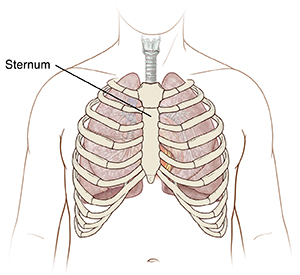You have a break (fracture) of the sternum. This is the long, flat bone that goes down the middle of the chest. It’s also called the breastbone. The sternum is connected by cartilage to the ribs, and forms the front of the ribcage. The ribcage helps to protect the heart and lungs underneath.
A sternum fracture is often caused by a blunt force injury to the chest. It most often occurs due to a car accident, a fall from a height, or a sports injury.
A diagnosis is typically done with a chest X-ray or a CT scan of the chest.
Treatment will depend on how severe the injury is. In most cases, a broken sternum heals on its own with rest and the general home care tips below. It may take about 10 weeks to heal. In some cases, surgery is needed to repair the sternum. Or there may be an additional injury. This may be a rib fracture, or bruising (contusion) of the heart or lungs.
A sternum fracture is very painful. It will also hurt when you cough, breathe deeply, sneeze, or laugh. But it’s important not to let the pain stop you from taking a deep breath or from coughing. Deep breathing allows more air into your lungs. And coughing helps to get rid of excess mucus in the lungs. If too much mucus builds up, it can lead to complications like pneumonia. Your healthcare provider will talk with you about doing gentle coughing and regular deep breathing exercises as you recover.
Home care
A sternum fracture often heals on its own. Here’s how to take care of yourself at home:
-
Pain medicines. Your healthcare provider may prescribe medicines to ease pain. Otherwise ask your provider if it’s OK to take an over-the-counter medicine for pain relief. Talk with your provider before taking these medicines if you have chronic liver or kidney disease. Also talk with your provider if you’ve had an ulcer or digestive bleeding.
-
Ice packs. Using ice packs can help ease pain and swelling. Apply ice packs to your chest for about 10 to 20 minutes, every 1 to 2 hours. Do this for the next 72 hours. To make an ice pack, put ice cubes in a plastic bag that seals at the top. Wrap the ice pack in a thin towel or cloth before using it. Don’t put an ice pack directly on your skin.
-
Coughing and deep breathing. As you recover, it’s important to take deep breaths and do some gentle coughing, despite the pain. This helps reduce your risk of pneumonia or other lung problems. Your provider will give you some guidance and helpful tips. You may be told to cough or breathe deeply at least every hour. It may be less painful to do this if you hold a pillow against your chest.
-
Rest. Letting your body rest is an important part of the healing process.
-
Activities. Don’t lift anything or do any activities that cause pain or put pressure on your chest. Talk with your healthcare provider about what kind of gentle activity is OK to do. Ask when you can go back to your normal activities.
Follow-up care
Follow up with your healthcare provider, or as advised. They’ll monitor how well you’re healing.
If X-rays or CT scans were taken, you’ll be told of any new findings that may affect your care.
When to get medical advice
Call your healthcare provider if any of these occur:
-
Fever of 100.4°F (38°C) or higher, or as directed by your provider
-
Feeling dizzy or lightheaded
-
Coughing up blood
-
Coughing up mucus (sputum) that is a yellow or green color
-
A new pain in a different part of the body
Call 911
Call 911 right away if any of these occur:
-
Fast or irregular heartbeat
-
Trouble breathing
-
Passing out or losing consciousness
-
Shortness of breath that doesn’t go away, or that gets worse
-
Chest pain that doesn't go away, or that gets worse


